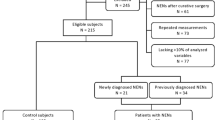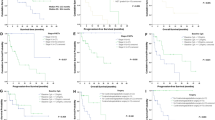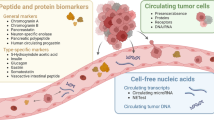Abstract
Circulating chromogranin A (CgA) level is a useful marker for diagnosis and treatment efficacy monitoring of neuroendocrine tumors (NETs). To evaluate the diagnostic value of serum CgA in well-differentiated non-functioning NETs and to investigate the correlation between changes in serum CgA levels and imaging responses in patients with locally advanced or metastatic disease, 60 healthy controls and 82 patients with NETs (28 with localized NETs and 54 with advanced NETs) treated between December 2010 and November 2014 were included. CgA levels were determined by ELISA. Receiver-operating characteristic (ROC) curve analysis was used to evaluate the diagnostic sensitivity and specificity of serum CgA. Correlation between CgA levels and tumor burden was analyzed. Serial CgA measurements and tumor responses (evaluated according to the RECIST 1.1 criteria) in 40 patients with locally advanced or metastatic disease were recorded. Using a cutoff value of 84 ng/mL, the sensitivity of serum CgA was 67 %, with a specificity of 78 %. Serum CgA levels of patients with different tumor burdens were significantly different. Progressions were observed in 38 out of 122 visits. Using a 28 % increase of serum CgA concentration as the best cutoff value, the sensitivity and specificity were 79 and 86 %, respectively, with positive and negative predictive values of 71 and 90 %, respectively, to determine disease progression. Serum CgA measurement had a modest sensitivity for the diagnosis of non-functioning NETs. However, increases of CgA levels combined with imaging might be helpful in detecting tumor progression in patients with NETs.



Similar content being viewed by others
References
Donckier JE, Michel L. Phaeochromocytoma: state-of-the-art. Acta Chir Belg. 2010;110:140–8.
Berruti A, Baudin E, Gelderblom H, Haak HR, Porpiglia F, Fassnacht M, et al. Adrenal cancer: ESMO clinical practice guidelines for diagnosis, treatment and follow-up. Ann Oncol. 2012;23 Suppl 7:vii131–138.
van der Lely AJ, de Herder WW. Carcinoid syndrome: diagnosis and medical management. Arq Bras Endocrinol Metabol. 2005;49:850–60.
Vaidakis D, Karoubalis J, Pappa T, Piaditis G, Zografos GN. Pancreatic insulinoma: current issues and trends. Hepatobiliary Pancreat Dis Int. 2010;9:234–41.
Bosman F, Carneiro F, Hruban RH, Theise ND. WHO classification of tumours of the digestive system. Lyon: IARC Press; 2010.
Berretta M, Cappellani A, Di Vita M, Berretta S, Nasti G, Bearz A, et al. Biomarkers in neuroendocrine tumors. Front Biosci (Schol Ed). 2010;2:332–42.
Bajetta E, Ferrari L, Martinetti A, Celio L, Procopio G, Artale S, et al. Chromogranin A, neuron specific enolase, carcinoembryonic antigen, and hydroxyindole acetic acid evaluation in patients with neuroendocrine tumors. Cancer. 1999;86:858–65.
d’Herbomez M, Do Cao C, Vezzosi D, Borzon-Chasot F, Baudin E, groupe des tumeurs endocrines (GTE France). Chromogranin A assay in clinical practice. Ann Endocrinol (Paris). 2010;71:274–80.
Massironi S, Rossi RE, Casazza G, Conte D, Ciafardini C, Galeazzi M, et al. Chromogranin A in diagnosing and monitoring patients with gastroenteropancreatic neuroendocrine neoplasms: a large series from a single institution. Neuroendocrinology. 2014;100:240–9.
O’Connor DT, Deftos LJ. Secretion of chromogranin A by peptide-producing endocrine neoplasms. N Engl J Med. 1986;314:1145–51.
Zatelli MC, Torta M, Leon A, Ambrosio MR, Gion M, Tomassetti P, et al. Chromogranin A as a marker of neuroendocrine neoplasia: an Italian multicenter study. Endocr Relat Cancer. 2007;14:473–82.
Kocha W, Maroun J, Kennecke H, Law C, Metrakos P, Ouellet JF, et al. Consensus recommendations for the diagnosis and management of well-differentiated gastroenterohepatic neuroendocrine tumours: a revised statement from a Canadian national expert group. Curr Oncol. 2010;17:49–64.
Portela-Gomes GM, Stridsberg M. Selective processing of chromogranin A in the different islet cells in human pancreas. J Histochem Cytochem. 2001;49:483–90.
Laslop A, Doblinger A, Weiss U. Proteolytic processing of chromogranins. Adv Exp Med Biol. 2000;482:155–66.
Stridsberg M, Eriksson B, Oberg K, Janson ET. A comparison between three commercial kits for chromogranin A measurements. J Endocrinol. 2003;177:337–41.
Arnold R, Wilke A, Rinke A, Mayer C, Kann PH, Klose KJ, et al. Plasma chromogranin A as marker for survival in patients with metastatic endocrine gastroenteropancreatic tumors. Clin Gastroenterol Hepatol. 2008;6:820–7.
Nehar D, Lombard-Bohas C, Olivieri S, Claustrat B, Chayvialle JA, Penes MC, et al. Interest of chromogranin A for diagnosis and follow-up of endocrine tumours. Clin Endocrinol (Oxf). 2004;60:644–52.
Janson ET, Holmberg L, Stridsberg M, Eriksson B, Theodorsson E, Wilander E, et al. Carcinoid tumors: analysis of prognostic factors and survival in 301 patients from a referral center. Ann Oncol. 1997;8:685–90.
Nobels FR, Kwekkeboom DJ, Coopmans W, Schoenmakers CH, Lindemans J, De Herder WW, et al. Chromogranin A as serum marker for neuroendocrine neoplasia: comparison with neuron-specific enolase and the alpha-subunit of glycoprotein hormones. J Clin Endocrinol Metab. 1997;82:2622–8.
Jensen KH, Hilsted L, Jensen C, Mynster T, Rehfeld JF, Knigge U. Chromogranin A is a sensitive marker of progression or regression in ileo-cecal neuroendocrine tumors. Scand J Gastroenterol. 2013;48:70–7.
Wang YH, Yang QC, Lin Y, Xue L, Chen MH, Chen J. Chromogranin A as a marker for diagnosis, treatment, and survival in patients with gastroenteropancreatic neuroendocrine neoplasm. Medicine (Baltimore). 2014;93:e247.
Tateishi K, Kitayama N, Matsuoka Y, Funakoshi A. Comparison of chromogranin A and pancreastatin levels in plasma of patients with pancreatic islet cell tumor. Life Sci. 1995;57:889–95.
Moattari AR, Deftos LJ, Vinik AI. Effects of sandostatin on plasma chromogranin-A levels in neuroendocrine tumors. J Clin Endocrinol Metab. 1989;69:902–5.
Igaz P, Mullner K, Hargitai B, Igaz I, Tombol Z, Racz K, et al. Marked chromogranin A elevation in a patient with bilateral adrenal incidentalomas, and its rapid normalization after discontinuation of proton pump inhibitor therapy. Clin Endocrinol (Oxf). 2007;67:805–6.
Eisenhauer EA, Therasse P, Bogaerts J, Schwartz LH, Sargent D, Ford R, et al. New response evaluation criteria in solid tumours: revised RECIST guideline (version 1.1). Eur J Cancer. 2009;45:228–47.
Travis WD, Brambilla E, Muller-Hermelink HK, Harris CC. Tumours of the lung, pleura, thymus and heart. World Health Organization classification tumours. Pathology and genetics. Lyon: IARC Press; 2004.
Ferolla P, Faggiano A, Mansueto G, Avenia N, Cantelmi MG, Giovenali P, et al. The biological characterization of neuroendocrine tumors: the role of neuroendocrine markers. J Endocrinol Invest. 2008;31:277–86.
Lawrence B, Gustafsson BI, Kidd M, Pavel M, Svejda B, Modlin IM. The clinical relevance of chromogranin A as a biomarker for gastroenteropancreatic neuroendocrine tumors. Endocrinol Metab Clin North Am. 2011;40:111–34. viii.
Stivanello M, Berruti A, Torta M, Termine A, Tampellini M, Gorzegno G, et al. Circulating chromogranin A in the assessment of patients with neuroendocrine tumours. A single institution experience. Ann Oncol. 2001;12 Suppl 2:S73–77.
de Herder WW. Biochemistry of neuroendocrine tumours. Best Pract Res Clin Endocrinol Metab. 2007;21:33–41.
Borglum T, Rehfeld JF, Drivsholm LB, Hilsted L. Processing-independent quantitation of chromogranin A in plasma from patients with neuroendocrine tumors and small-cell lung carcinomas. Clin Chem. 2007;53:438–46.
Abou-Saif A, Gibril F, Ojeaburu JV, Bashir S, Entsuah LK, Asgharian B, et al. Prospective study of the ability of serial measurements of serum chromogranin A and gastrin to detect changes in tumor burden in patients with gastrinomas. Cancer. 2003;98:249–61.
Chan JA, Stuart K, Earle CC, Clark JW, Bhargava P, Miksad R, et al. Prospective study of bevacizumab plus temozolomide in patients with advanced neuroendocrine tumors. J Clin Oncol. 2012;30:2963–8.
Acknowledgments
We are highly thankful to the patients for their invaluable participation, as well as to the radiology and laboratory staff.
Compliance with ethical standards
ᅟ
Conflicts of interest
None
Ethics approval
The study involved human participants and was approved by the ethical committee of the Peking Union Medical College Hospital. All participants provided a written informed consent. The study was conducted in accordance with the Declaration of Helsinki.
Author information
Authors and Affiliations
Corresponding author
Additional information
Yuejuan Cheng and Zhao Sun contributed equally to this study.
Rights and permissions
About this article
Cite this article
Cheng, Y., Sun, Z., Bai, C. et al. Serum chromogranin A levels for the diagnosis and follow-up of well-differentiated non-functioning neuroendocrine tumors. Tumor Biol. 37, 2863–2869 (2016). https://doi.org/10.1007/s13277-015-4114-7
Received:
Accepted:
Published:
Issue Date:
DOI: https://doi.org/10.1007/s13277-015-4114-7




